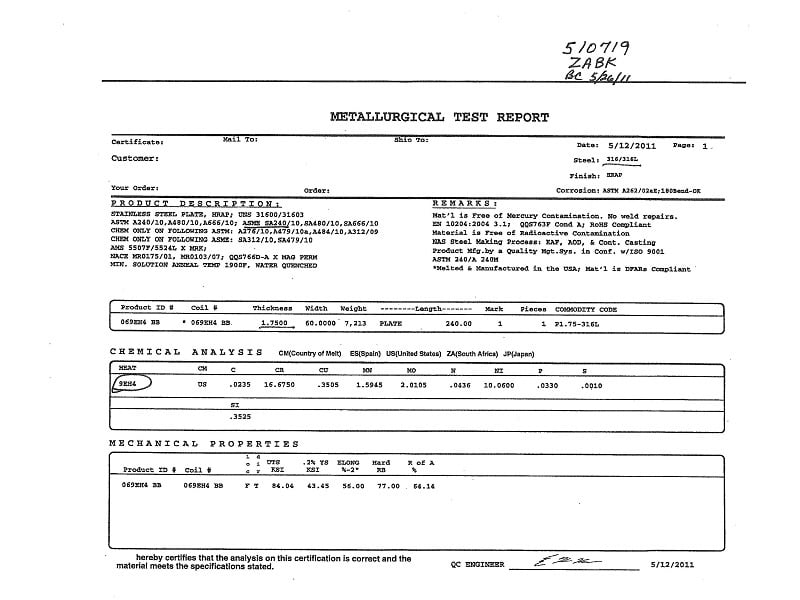1.5 minute read
If you've worked in the stainless steel industry for any period of time, chances are you've seen an informational sheet similar to the one above. Some companies, like Paul Mueller, even hire full-time professionals to handle quality assurance and paperwork like these Mill Test Reports. Keep reading to learn more about Mill Test Reports and the important role they play in the stainless steel industry.
What is a Mill Test Report?
A Mill Test Report (MTR) documents a material's physical and chemical properties. These quality assurance certificates show a metal product's compliance with international standards. ANSI and ASME are two of the most important and common standards that require MTR information. Other names for mill test reports include:
- Certified Mill Test Report
- Certified Material Test Report
- Mill Certification
- Mill Inspection Certificate
What's in a Mill Test Report?
In the steel industry, an MTR may include some or all of the following information:
- Material Heat Number
- Material Grade
- Edition Year and Type of Specifications Met
- Material Dimensions
- Mechanical Properties
- Chemical Analysis
- Heat Treatment (if applicable)
- Certified Inspector Signature2
Why are MTRs so important?
MTRs are important for both fabricators and their customers. These reports confirm that the material or product received meets specifications. Certain sanitary products need certain material compositions to preserve the quality of the product. An MTR is proof that a material complies with the standard needed for the application.
Additionally, ASME requires that items have traceability. Companies also have to keep MTRs for up to three years after production has taken place. Companies with outstanding quality programs organize a database to keep track of these documents.
What role does the heat code/number play?
A heat code (or heat number) tracks which batch of metal an individual piece of metal came from. Metal providers and component manufacturers have a tracking process to ensure quality and reliability. This tracking process includes at least these four items:
- Mill Heat Codes
- Material Purchase Order
- Component Manufacturer Heat Codes
- A method for tracing mill heat codes to manufacturer heat codes
The most common practice used to track heat codes is to stamp or rewrite them on the metal. Some metal suppliers will use tracer numbers, but this technique is less common. When the metal ships to product manufacturing facilities, the manufacturer becomes responsible for tracking.
Large manufacturing companies often issue a unique heat code to received material. This provides a way for manufacturers to track material within their own production system. It also enables them to have more specific traceability for their customers.
If this article was helpful to you, we've created another resource to help you learn more about the tank components industry. Click the link below to download the Tank Component Buyer's Glossary of Terms.
1. https://hollandaptblog.com/2015/01/08/what-is-a-mill-test-report-mtr-and-why-is-it-important/
2. http://www.mtm-inc.com/ag-20120628-how-to-review-a-certified-mill-test-report.html



